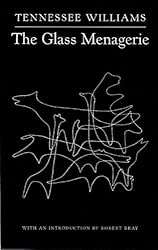Are you wondering, “Why is The Glass Menagerie called “a memory play?” This reading guide discusses Tennessee Williams’s famed play The Glass Menagerie as a memory play, shedding light on how Williams blurred the lines between past and present. Enter the fragile world of the Wingfield family through the lens of memory. Let’s get literary!
Quick Summary
The Glass Menagerie is an example of a memory play because it is told directly through the memory of one character, Tom Wingfield. According to Tom himself, this means it is “not realistic.” Memory is “truth in the pleasant disguise of illusion.”
In The Glass Menagerie, memory and the past are themes positing that the members of the Wingfield family cannot be happy in the present because, in some way, each of them is stuck in the past.
Memory is important to understanding The Glass Menagerie because memory is subjective and incomplete. This taints Tom Wingfield’s narration of The Glass Menagerie, but it also dramatizes and clarifies how each member of the Wingfield family is bound from achieving present happiness based on the trappings of their memories of the past.
Full Discussion of The Glass Menagerie As a Memory Play
Background
Catapulting Tennessee Williams to fame, the 1944 play The Glass Menagerie relies on style and content about memory to convey its meaning.
Why? First, memory is subjective and, second, memory is overpowering.
The Glass Menagerie remains a cultural icon, being one of the many books referenced on the TV show Gilmore Girls.
Characters and Plot
Set in a low-class St. Louis apartment in the 1930s, it offers a window into a few relatively inconsequential moments in the lives of the Wingfield family to show the stronghold that memory has had on their happiness:
- Amanda Wingfield is the mother. A former Southern belle, she is disillusioned and trapped in ideas of the past, when men called on her. She believes marriage is the key to happiness for her daughter, Laura.
- Laura Wingfield is a twentysomething high school dropout, who hasn’t done much of anything since but play with her collection of glass animal trinkets, listen to old records, and recall the high school crush she once had. She walks with a limp and is extremely shy and naive.
- Tom Wingfield is her twentysomething brother, a poet who dreams of a life of adventure but works in a factory to support his family, a painful reminder of the father who abandoned them.
In fact, the patriarch appears only in memory format, as a photograph on the wall, and not in real life.
The bulk of the story is a very simple one in which Amanda finds out that Laura secretly dropped out of business school and convinces Tom to invite a “gentleman caller” to come to dinner to meet Laura and, hopefully, become her husband someday.
Analysis
What makes such a simple story a work of theatrical work of art is how it’s told as a memory play. The narrator, Tom, states this in his opening soliloquy:
“Yes, I have tricks in my pocket, I have things up my sleeve. But I am the opposite of a stage magician. He gives you an illusion that has the appearance of truth. I give you truth in the pleasant disguise of illusion.”
Here, the theme of illusion ties into the theme of memory both directly, as memory is never perfect but rather, filled with subjective illusions, and indirectly, as the characters face disillusionment about the past in each of their own lives that prevents their current happiness.
Tom then explicitly states he “turn[s] back time” to tell this story. He notes that the play is “dimly lighted, it is sentimental, it is not realistic.” This is a visual representation of how memory appears in the mind — skewed and unclear.
Tom also refers to how “[i]n memory everything seems to happen to music.” This is why music plays at various moments throughout the play.
Tom then admits to what will soon be learned very clearly: that he and his family are the least realistic characters in the play. Again, this alludes to how memory affects storytelling. The characters’ words and actions feature more or less prominently, depending not on how they occurred, but on how they are remembered by this narrator.
For example, Tom holds a lot of disdain for his mother’s overbearing nature and dramatic flare, so these characterizations are highly exaggerated throughout the play. Amanda’s character remains consistently over-the-top and almost cartoonish. Likewise, Laura is not just shy, but painfully shy, to the point where being in a gentleman caller’s presence makes her physically ill.
Indeed, Amanda’s obsession with the past plays a role in The Glass Menagerie as a memory play, for Tom is not the only one trapped by his memories. Amanda simply cannot grasp her present reality, and Laura’s childlike naivety, old phonograph records, and even her teenage recollections of the gentleman caller, Jim, are grounded in memory.
The Glass Menagerie can also be seen as a memory play through the photograph of the father that hangs on the wall. Photographs essentially are memories, and this is all that remains to the Wingfields of the man who abandoned them.
The foil to the Wingfields is, in fact, Jim. He recalls the past, but he isn’t bound by it, and thus he is able to find happiness in the present for all of life’s trials and tribulations.
Naturally, he escapes the grasp of the Wingfields after just one short evening. In memory, Tom presents him generally as a “nice guy” — lighthearted, kind, and free-spirited.
Additionally, in discussing The Glass Menagerie as a memory play, it’s worth noting that the stage directions occasionally refer to screencasts of important words and images in the play, such as “Blue Roses,” which Jim referred to Laura as during high school, upon mishearing her say she had “pleurosis.” This may be interpreted to be memory-like, in the way one’s brain can recall important things in flashes and/or bits and pieces.
Even Laura’s glass figurines can be seen as a symbol of memory, for glass is clear but when viewed at certain angles and in certain lighting, it offers unique and colorful reflections that differ.
Lastly, as the play ends and Tom reveals that time has passed and he has since moved away, the trappings of memory become all the more clear. Even though, like his father, he has left his mother and sister behind, he remains trapped by their memory in retelling this story.
This may remind the very literary reader of the ending of The Great Gatsby, which reflected on the American Dream at a similar time in history:
So we beat on, boats against the current, borne back ceaselessly into the past.”
– F. Scott Fitzgerald
Frequently Asked Questions
The Glass Menagerie is a memory play because it is told directly through the memory of one character, Tom Wingfield. Memory is important to understanding The Glass Menagerie because it is subjective and incomplete. This taints the narration of The Glass Menagerie, but it also dramatizes and clarifies how each member of the Wingfield family is bound from achieving present happiness based on the trappings of their memories of the past.
The Glass Menagerie is narrated through Tom Wingfield’s memory. He is Amanda’s son and Laura’s brother, as well as a twentysomething poet who dreams of a life of adventure but works in a factory to support his family.
No. The Glass Menagerie is a 1944 play by Tenneessee Williams about the fictional Wingfield family, bound from achieving present happiness based on the trappings of their memories of the past.
Conclusion
In exploring The Glass Menagerie as a memory play, we’ve seen how Tennessee Williams highlights the fragile nature of human connections and the power of memory. This masterpiece not only reflects on the impact of our past, but it also demonstrates the enduring influence of memories in shaping our stories. Williams’ play invites us into a reflective, poignant journey, proving that our recollections hold the power to both haunt and heal.
Buy The Glass Menagerie:



